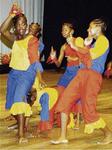
Winston Sill/Freelance Photographer
Participants in the inaugural JCDC 'Dance Competition for the Deaf', held at the Philip Sherlock Centre for the Creative Arts, UWI, Mona Campus, on May 24, 2006.Sadeke Brooks, Staff Reporter
Without being able to hear, it seems almost impossible for someone to be able to dance. However, with a routine and just through feeling the vibrations from the music, this can be achieved.
The Jamaica Cultural Development Commission (JCDC) has been helping deaf students across the island to show off their dancing abilities through their annual Deaf Dance Competition, which will be held May this year. The competition was added to the JCDC calendar in 2006 and has been receiving strong support since.
The students come from several schools across the island. Among them are the Lister Mair Gilby School for the Deaf, the Jamaica Christian Centre in St James, St Christopher's School for the Deaf, Clonmel Cultural Academy, Caribbean Christian Academy and the Danny Williams School for the Deaf.
In order to help these students excel, the JCDC hosted a deaf dance workshop for the teachers at the Edna Manley College for the Visual and Performing Arts on April 12 and 13 this year.
Renée Robinson, director of Programmes at the JCDC, says since receiving training, the teachers have been able to teach the students better, thereby improving their performance in the competition.
"There are students from these institutions who are now entering the regular performing arts competition and at the same standards as those who are not deaf. With the training, you see the difference in the quality of their presentations. It's much stronger," Robinson told The Sunday Gleaner. The teachers at the workshop were instructed in the various methodologies used for teaching the hearing impaired, as well as the technical rigours of creative, folk and modern dance.
WORKSHOP
The workshop was conducted by Howard Daly, who is a dance instructor at the Edna Manley College for the Visual and Performing Arts. He explained that he explored composition with the teachers, which showed them how to build a dance.
"Dance is like language. You start with a theme then make opening statements, develop on those statements, and then make a conclusion," said Daly.
He said the teachers had to learn the steps and the moves that would fit each genre. They also had to learn how to teach the deaf students, as they learn differently from children who are not hearing impaired.
"To get a deaf person to dance, they have to get sensitised to the music. They hold the tape recorder in their hands and feel the vibrations, and try to memorise the sequence the teachers dance and copy those movements. They play back in their memory how the sequence and vibrations went," said Daly.
In addition, the speakers are put on the floor and the students feel the vibrations in their feet. Daly says the students can only dance from what they remember of the vibrations. However, the vibrations are not enough to form a routine, which is why the teachers are taught the components of dance.
Margaret Daley, dance teacher for the Caribbean Christian Academy's programme for the deaf, participated in the workshop. She said: "Deaf dancers need many hours of practice in order to develop an inner sense of timing for a specific routine to be established."
She added: "Some dancers have residual hearing, which allows them to pick up cues from the music and assists them in knowing where they are supposed to be in a dance. Generally, however, it usually takes hours of practice and having them imitate and count all the movements in a dance step to complete a piece of choreography."
It was more a case of actually learning certain symbols in sign language that provided some challenge for Howard Daly.
MAJOR CHALLENGES
"The major challenge is in communicating specific instructions, and this is why it is critical that the teacher has in-depth knowledge of sign language and of the hearing ability of each student," he said.
Daly said that it is also important that the teacher is always in the student's sight so that they can see what the teacher is trying to demonstrate.
While not saying whether the deaf are better dancers than those who are not hearing impaired, Daly admitted that the deaf have an advantage because they show their emotions better.
"They tend to internalise the feelings because they are not as inhibited as the regular person when they try to express emotions. But there are some challenges when they try to keep the beat," he said.

